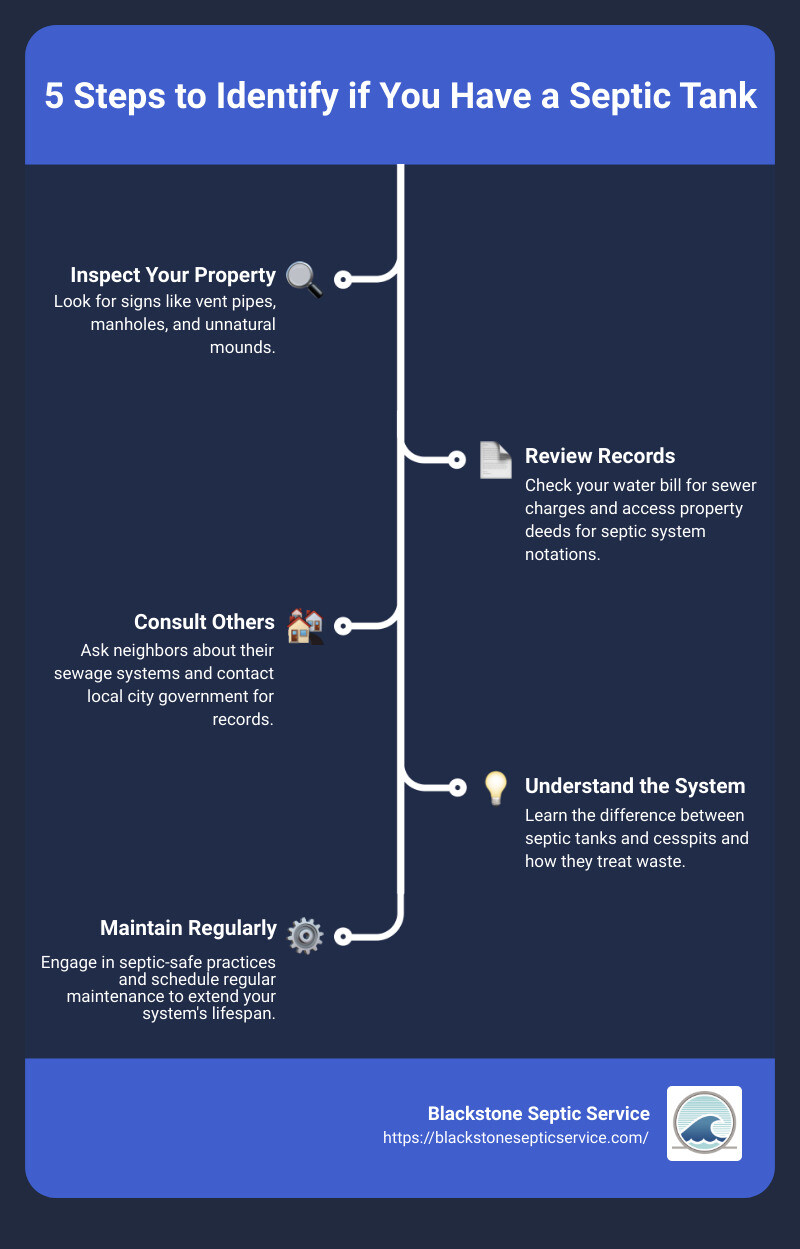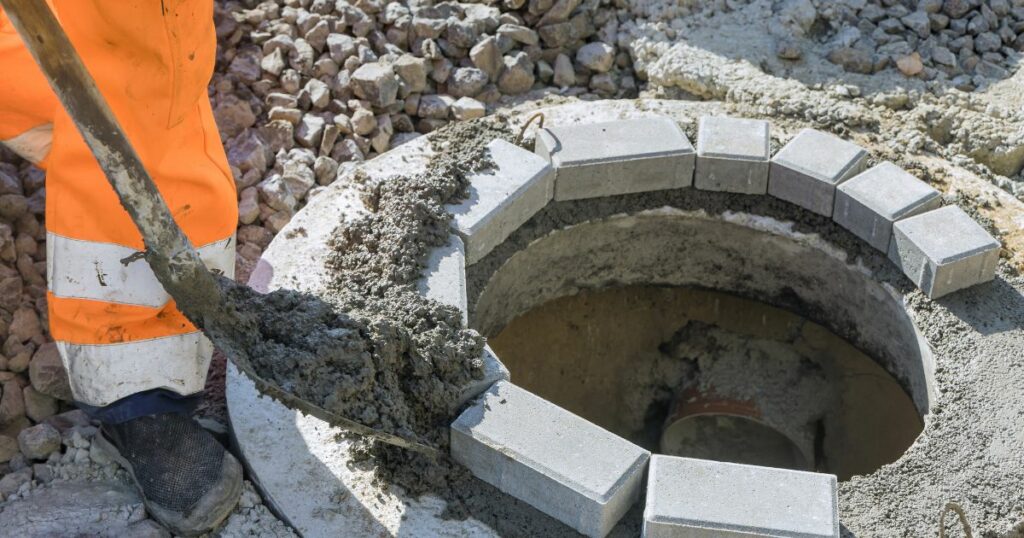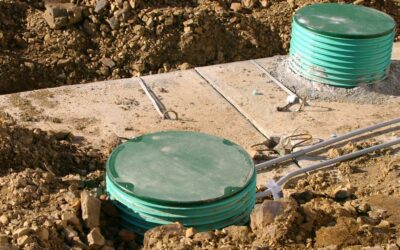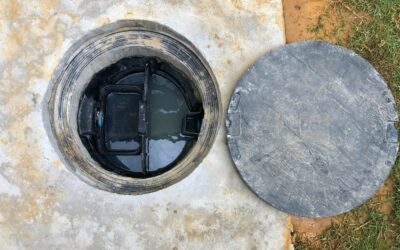Ever found yourself scratching your head and wondering, “How do I know if I have a septic tank at my home?” You’re not alone. It’s a common question we hear often at Blackstone Septic Service.
Figuring out whether your home has a septic tank can seem a daunting task, but it doesn’t have to be. With years of experience under our belt in servicing homes in Central MA and beyond, we understand the importance of identifying if your property has a septic tank and thought it would be a good idea to guide you through the process.
Septic tanks play a crucial role in managing wastewater in many homes. Usually made from concrete, polyethylene, or fiberglass, these watertight containers are located underground and treat the household wastewater by allowing solids and oils to separate from the water.
Importance of Knowing if You Have a Septic Tank
Recognizing if your home has a septic system is important for several reasons. One, it enables you to maintain and care for it appropriately, extending its lifespan. Knowing where it’s located can prevent you from placing heavy items on top which can damage it over time. Most importantly, you will also be better prepared to identify warning signs of septic failure and schedule regular maintenance services to prevent serious issues.

To help you in your quest to find out if you have a septic tank, here are some indicators:
- Inspect your property for signs: Look for unnatural hills or mounds, or visible pipes that could indicate the presence of a septic tank.
- Check your water bill and records: A $0 sewerage charge on your water bill is a sign of having a septic tank.
- Consult neighbors or local authorities: Often, homes within the same locality have similar systems. So, reaching out to your neighbours or local authorities could provide the answer.
- Monitor functionality of your system: Slow draining pipes or foul-smelling wet areas in your yard could indicate a failing septic system.
- Get a professional inspection: If in doubt, engage a professional service like Blackstone Septic Service to check your property.
Stay tuned as we delve into these steps in detail in the following sections.
Table of Contents
Step 1: Inspect Your Property
The first step in a septic inspection and figuring out ‘how do I know if I have a septic tank’ is by doing a thorough inspection of your property. This involves looking for some telltale signs that could suggest the presence of a septic tank system.
Signs of a Septic Tank on Your Property
Look for manholes and vent pipes: These are usually the most visible signs of a septic system. A septic tank typically has 2, 3, or 4 manholes in close proximity to each other above ground. . Additionally, you might also notice vent pipes that help distribute unpleasant gasses from the tank into the air.
Check for regular tank emptying: If you have been living on the property for a while and you find that the tank needs to be emptied every year, it’s a clear indication of a septic tank system.
Watch out for wet or soggy areas: Unexplained wet or soggy areas on your property, especially those with waste odors, might be a sign of a leach field, which is part of a septic system.
How to Identify Septic Tank Vent Pipes and Manholes
Septic tank vent pipes and manholes are often covered by green caps and can be easily spotted if you know what you’re looking for. The vent pipes are designed to release gasses from the septic tank to the atmosphere, keeping your home odor-free. The manholes, on the other hand, provide access to the tank for pumping and maintenance purposes.
The Role of Unnatural Hills or Mounds in Locating Septic Tanks
Unnatural hills or mounds on your property might indicate the location of a septic tank or drain field, as the soil in rural area is generally raised above these structures. However, it’s essential not to jump to conclusions based on this factor alone, as there could be other reasons for such formations in rural area. You might need to engage a professional service like Blackstone Septic Service to confirm.
In the next section, we’ll discuss how to use your water bill and property records to ascertain if you have a septic tank. Keep reading to learn more!
Step 2: Check Your Water Bill and Property Records
So, you’ve scoured your property and you’re still unsure if you have a septic tank. The next step in the process is to check your water bill and property records. These sources can provide valuable clues to help you answer the question, “how do I know if I have a septic tank?”
Understanding Your Water Bill: Sewer Amount Charged
One of the most straightforward ways to determine if you have a septic system is to take a look at your water bill. If you notice that your bill does not have a sewer amount charged, it’s likely that you have a septic system.
Why? Because when you are connected to a municipal sewer system, you usually pay a sewage fee to the local government to treat and dispose of your wastewater.
In contrast, homeowners with septic systems handle their own wastewater treatment, hence they aren’t billed for sewer services.
How to Access and Interpret Property Records
Another great resource for figuring out if you have a septic tank is your homeowner and property records. These records should ideally have information about the existence and location of a septic system. A permit for installing a septic system would have been issued and recorded when your home was built.
Accessing these records can often be done online via your local county or municipal office’s website. Alternatively, you can visit their office in person to request this information. Once you have the county records, look for blueprints, building permits or any other document that mentions a septic system.
Public Records and Septic Tank Locations
Public records can also be a gold mine of information about your septic system. In many areas, the local health department maintains records, including diagrams of where most septic tanks and systems are buried underground. You can make a public records request to get this information.
However, the age of your septic system may affect the availability of this data. Older systems may not have as detailed records as newer ones.
In the next section, we will discuss how to consult with neighbors and local city government to get more insights about your septic system. Also, if you find it challenging to interpret these records or need more precise information about your septic system, don’t hesitate to contact us. At Blackstone Septic Service, we’re always ready to assist you with our expertise and experience.
Step 3: Consult Your Neighbors and Local City Government
If you’re still wondering, “how do I know if I have a septic tank,” there’s no need to worry. There are still a few more steps you can take to find out for sure.
How Neighbors Can Help in Identifying Septic Tanks
One of the easiest ways to clarify your doubts is simply by asking your neighbors. Especially if your home and the homes around you were built around the same time, it’s likely that they also have a septic system. Even better, neighbors who have lived in the area for a long time may recall where your septic tank was installed or remember past maintenance performed on it.
The Role of Local City Government in Providing Septic System Information
Another great resource is your local city government. Most counties keep records of septic tank installations, which typically include diagrams showing the exact location of the tank within the property line.
To access these records, you can visit your local health department or your municipality’s office. These records can provide you with diagrams, visual signs and landmarks that can guide you towards your septic tank. They may also contain other essential details about your septic tank, such as its size or when it was last pumped.
If you’re not able to find a property survey map or other documentation explaining where your septic tank is, it can be worth creating your own map and documentation.
Then, if you end up selling your home at some point, you can provide the next homeowner with everything they need to find your septic tank, and maintain their septic system.
And, of course, if you need any help with this process, don’t hesitate to contact us at Blackstone Septic Service. We’re experts in septic systems and can provide you with all the guidance and services you need to keep your septic system in top shape.
Step 4: Understand the Functioning of Your Septic System
To answer the question, ‘how do I know if I have a septic tank’, it’s crucial to understand how a septic system functions. This step will assist in confirming whether you have a septic tank and help you recognize when it requires maintenance.
The Difference Between a Septic Tank and a Cesspit
A septic tank and a cesspit might appear similar, but they function differently. The primary distinction is that a septic tank has an outlet, while a cesspit does not. The wastewater in a septic tank is separated before it flows to the outlet and only discharges to the ground. A cesspit, on the other hand, is a holding tank that doesn’t discharge.
How a Septic System Separates and Treats Waste
A septic system works by separating household sewage into solid waste and liquid waste. The system uses bacteria to convert the organic matter in the sewage into less harmful solids. These solids can even be spread on your lawn as fertilizer. The liquid waste, once treated, is safe to be drained out through an outlet pipe.
One remarkable fact is that a properly functioning septic system can clean the water before it enters the groundwater. It’s a self-sustaining system that, if well-maintained, should last anywhere from 30 to 40 years.
Warning Signs That Your Septic Tank Needs to be Pumped
Recognizing the signs that your septic tank needs to be pumped is vital in maintaining your system’s health. Here are some common warning signs:
- Standing water over the drain field. Pooling water indicates that your effluent does not have anywhere to go.
- Rapid flora and fauna growth, like extra tall grass and weeds, over the drain field due to excess wastewater.
- Foul odor or sewage smell coming from your leach field.
- Slow to flush toilets and slow to drain sinks, even after treating them.
At Blackstone Septic Service, we recommend having your septic system pumped every 2-3 years. Regular maintenance helps prevent clogs and allows us to detect any potential issues early on.
If you’re unsure about your septic system’s condition or need help understanding how it works, we’re always here to assist. Our goal is to provide you with the knowledge and services needed to keep your septic system in top shape. If you notice any of the warning signs mentioned above, don’t hesitate to request our services.
Step 5: Maintain Your Septic System
Now that you’ve figured out ‘how do i know if i have a septic tank’ and understood its functioning, the next important step is to maintain it properly. A poorly maintained septic system can lead to serious issues such as sewage backups and expensive repairs. On the other hand, a well-maintained septic system can last for as long as 40 years!
Importance of Regular Septic Tank Maintenance
Regular maintenance of your septic system can extend its life and prevent major issues. We recommend having your septic system pumped every two to three years. This helps to prevent clogs in your tank from forming and also allows us to detect any potential issues during the routine maintenance process.
Don’t let your system go longer than 3-4 years without getting pumped!
Septic-Safe Practices: Toilet Paper and Avoiding Certain Substances
In order to maintain your septic system, it’s crucial to be mindful of what you flush down the toilet or pour down the drain. Stick to the basics: only human waste and toilet paper should be flushed. Avoid flushing non-biodegradable items such as wipes, feminine products, or oil, as they can clog your sewer pipes and disrupt the functioning of your septic system.
If possible, use toilet paper labeled “septic system safe” or “biodegradable”. Also, avoid pouring grease, pesticides, household chemicals, paints, and similar substances down your drain. These items can harm the healthy bacteria in your septic tank and drainfield that help break down organic matter.
The Impact of Chemical Cleaners on Septic System Bacteria
The bacteria in your septic and sewer system play a vital role in breaking down solid waste. However, certain substances, such as bleach and chemical cleaners, can kill these bacteria and disrupt the system’s balance. Limit the use of bleach and avoid using chemical cleaners. Instead, opt for boiling water or a drain snake to clean your drains.
In conclusion, maintaining your septic system is as important as knowing if you have one. If you need help with septic system maintenance or have any questions, don’t hesitate to contact us at Blackstone Septic Service. We’re committed to providing fast, reliable, and affordable services to homeowners in Central MA and surrounding areas.
How Do I Know If I Have a Septic Tank?
Identifying if you have a septic tank is crucial to maintaining a healthy and efficient waste management system in your home. To recap, here are the five steps we’ve discussed:
- Inspect Your Property: Look for signs such as vent pipes, manholes, or unnatural hills/mounds that might indicate the presence of a septic tank.
- Check Your Water Bill and Property Records: If your water bill includes a sewer amount charged, you’re likely connected to a municipal sewer system, not a septic tank. Property records can also provide useful information on whether a septic system is installed.
- Consult Your Neighbors and Local City Government: Neighbors with similar homes built around the same time may have septic systems. Local government offices can also provide information on septic system installations.
- Understand the Functioning of Your Septic System: Knowing the difference between a septic tank and a cesspit and understanding how your system separates and treats waste can help identify if you have a septic tank.
- Maintain Your Septic System: Regular maintenance of your septic system, using septic-safe practices, and avoiding substances harmful to septic bacteria are key to prolonging the lifespan of your septic system.
The Importance of Professional Help: Blackstone Septic Service

While these steps can guide you in determining whether you have a septic tank, professional help is often invaluable in this process. Misidentifying your waste system or failing to maintain it properly can lead to costly repairs and potential health and safety hazards.
At Blackstone Septic Service, we have seasoned experts who can help you identify and locate your septic system, conduct regular maintenance and provide emergency repair services as needed. Our dedicated team is committed to delivering fast, reliable, and affordable services to homeowners in Central MA and surrounding areas.
Final Thoughts on Septic Systems and Maintenance
Identifying if you have a septic tank is the first step to ensuring a well-functioning waste management system in your home. Regular maintenance, proper usage, and immediate attention to potential problems are key to a healthy and long-lasting septic system.
If you’re unsure about the presence or condition of your septic system, don’t hesitate to reach out to our team at Blackstone Septic Service. Our experienced technicians are always ready to provide you with professional and reliable septic inspection service.
For more information about septic maintenance and repair, visit our Resources page and Septic Services page. If you need immediate assistance, Request Service from us anytime.
How do I know if I have a septic tank is a question best answered with professional help. And at Blackstone Septic Service, we’re always here to assist you!
Our Content
Our experienced septic tank specialists have carefully reviewed and edited all of the content to ensure that it meets our high standards for quality and accuracy. At Blackstone Septic Service, our mission is to provide unparalleled expertise and service excellence in the realm of septic system care. With a dedicated team of professionals committed to delivering top-tier solutions, we specialize in comprehensive services encompassing everything from routine maintenance like septic tank pumping, sewage backup, and new system installations. Customer satisfaction is at the core of our operations, and we pride ourselves on our prompt, reliable, and customer-centric approach. Blackstone Septic Service is a family owned company with highly trained technicians, with over 75 years of experience in septic tanks.



